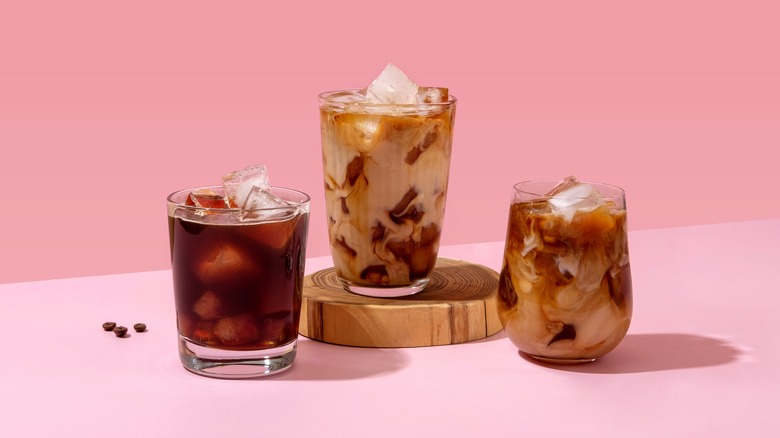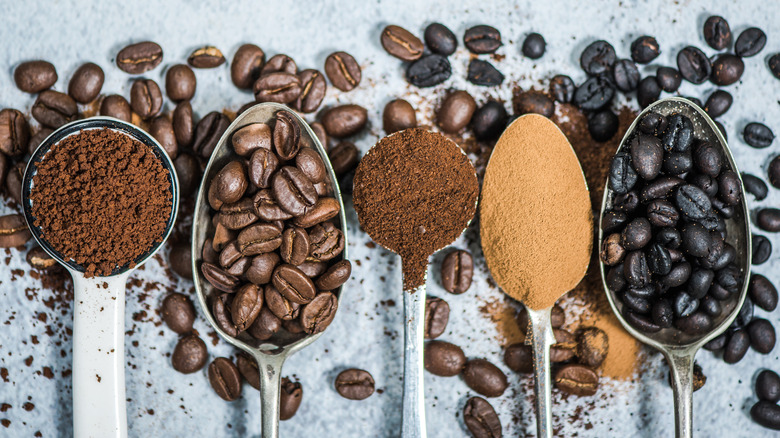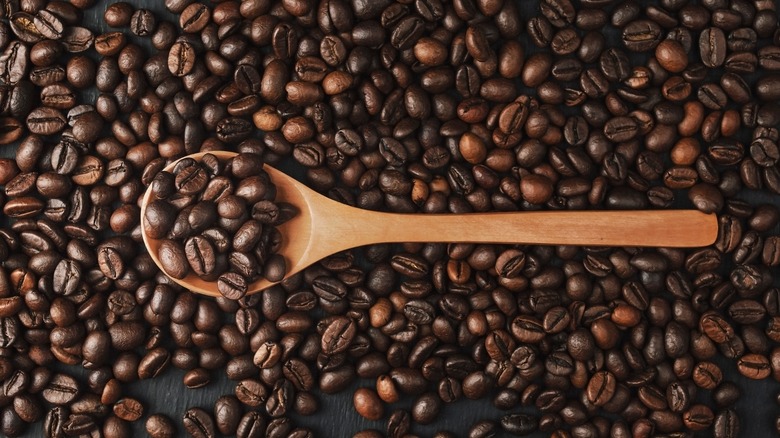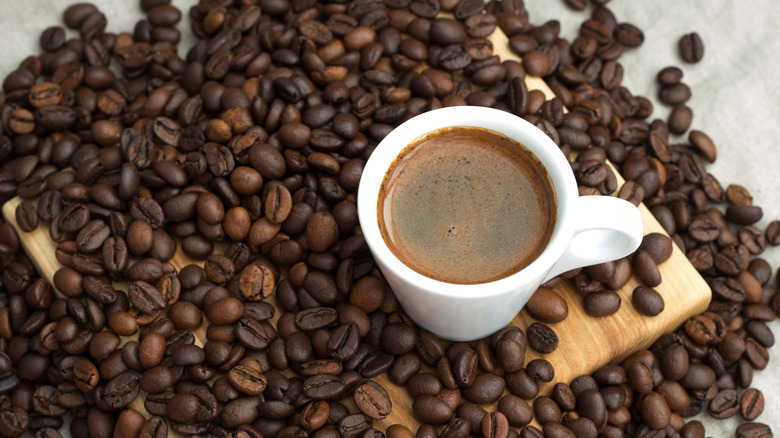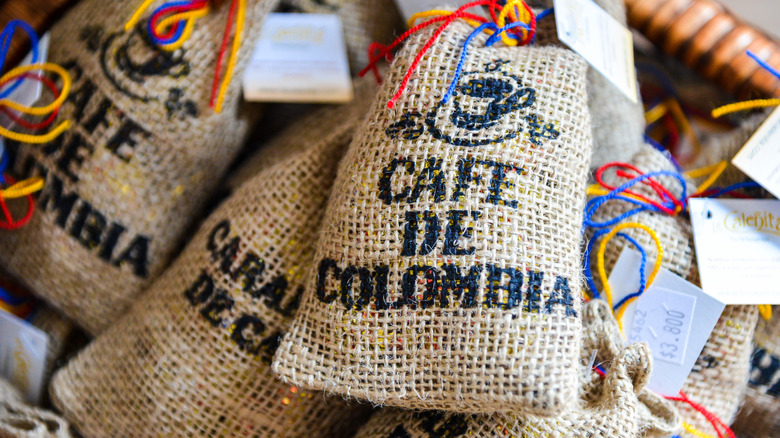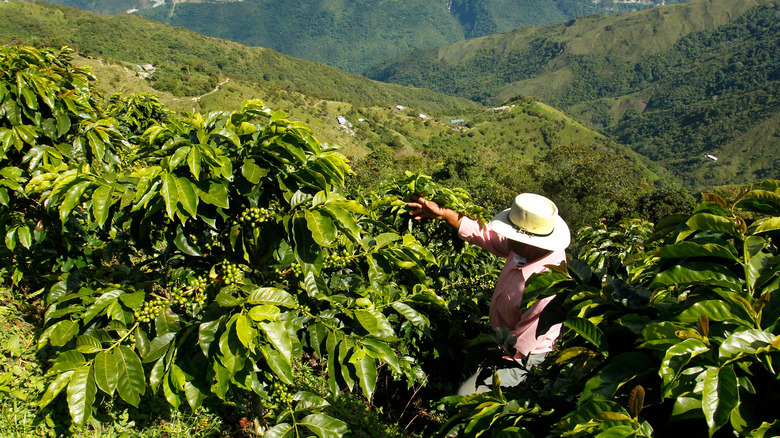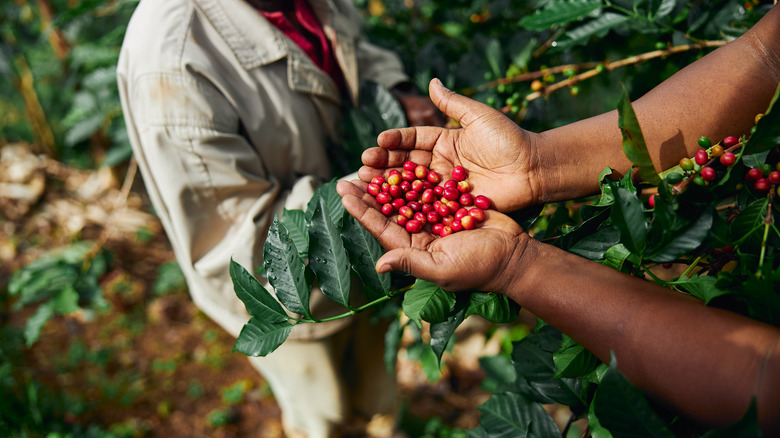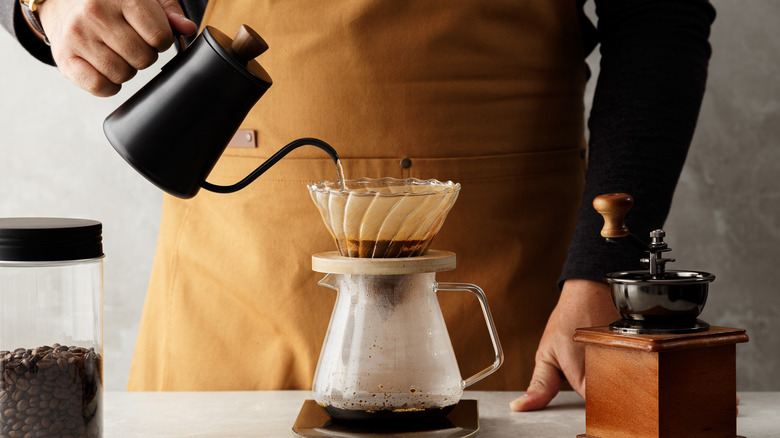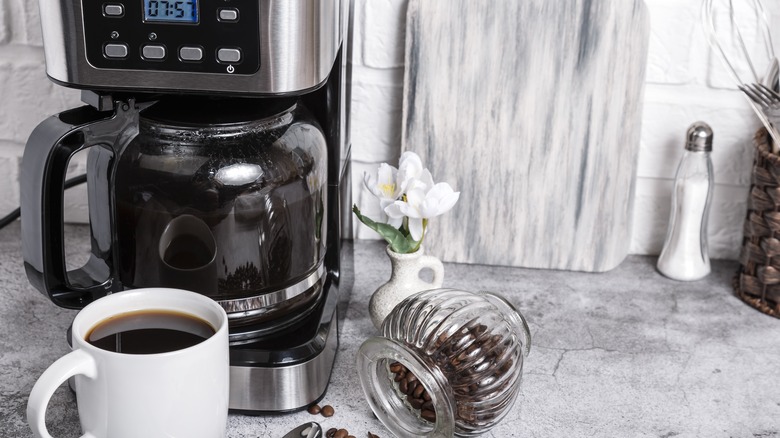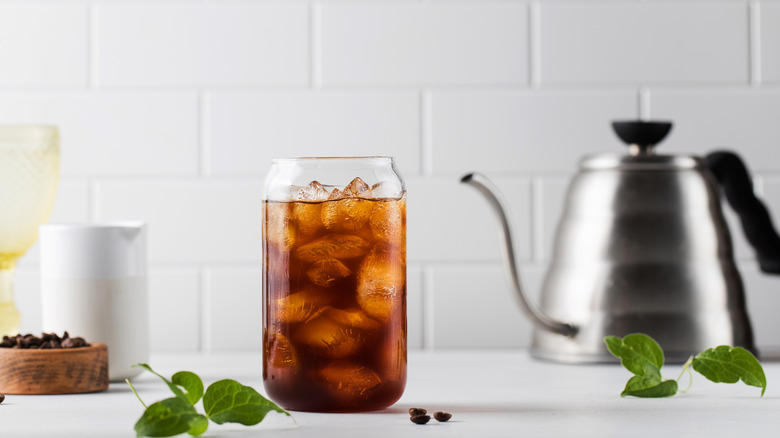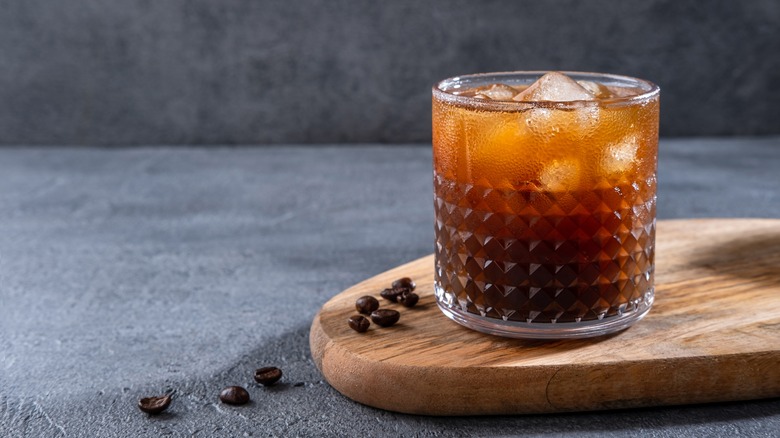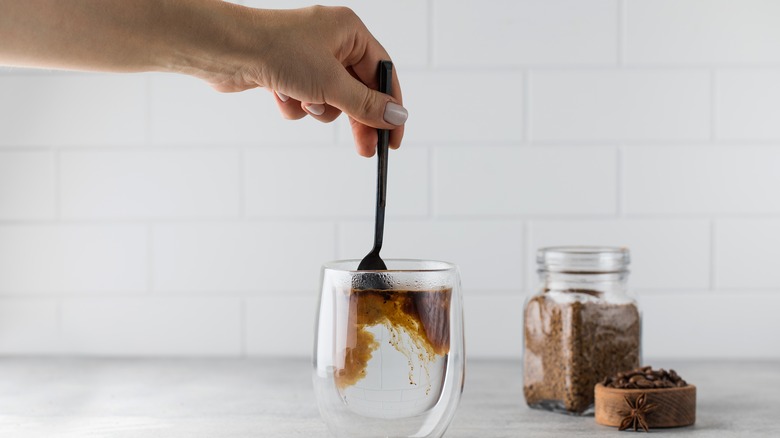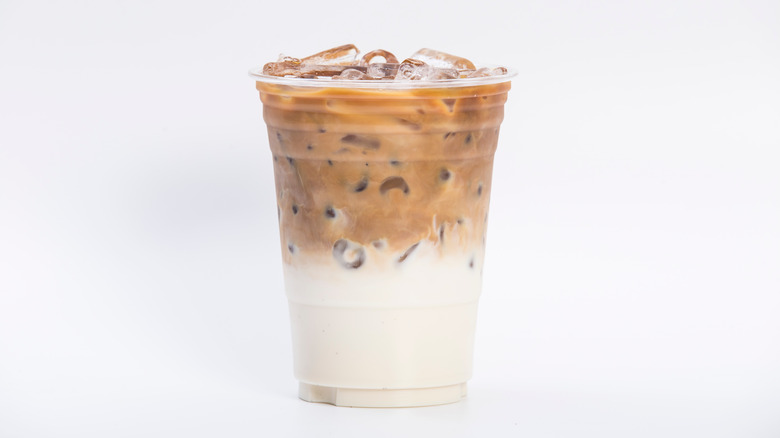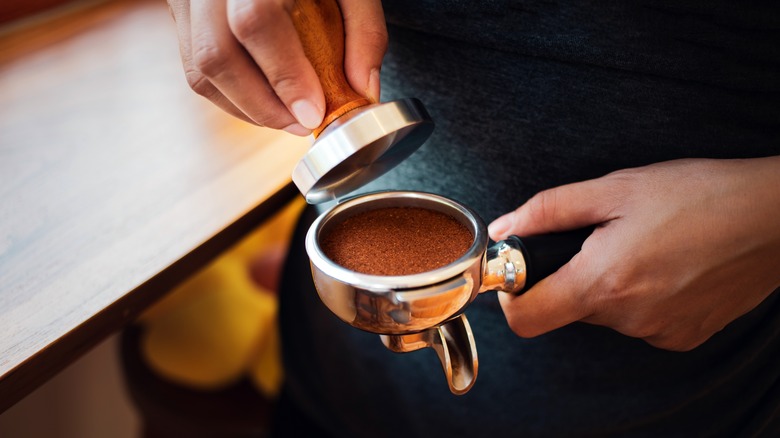13 Best Brewing Methods (And Beans) For Making Iced Coffee
While a cold beverage might spark memories of summer and a hot afternoon, iced coffee has become popular year-round. Its popularity has grown exponentially due, in no small part, to the Gen-Z target market that local coffee shops and corporations market towards. In 2022 alone, Starbucks' third quarterly report attributed nearly ¾ of its U.S. sales to cold beverages. The massive chain noted that customers are more likely to modify cold drinks than hot ones, and added syrups and alternative milk raise the final price of the drink.
For those of us looking to save a little money or are just interested in expanding our coffee knowledge at home, there are few easier drinks to make than the classic iced coffee. We spoke to Morgan Anderson from Central Coffee Co. in Charlotte, North Carolina about some of the best methods and beans that can be used for the best at-home iced coffee.
Pick a coffee with flavors you enjoy
Coffee, like any food, will have different flavor profiles depending on where it grows, how companies process it, and the time spent in the roasting chamber. That being said, coffee characteristics can differ wildly. The five key elements used to describe how a coffee tastes are flavor, sweetness, acidity, body, and finish.
Flavor determines the subtle undertones beyond just "coffee" and can include things like chocolate, nuts, and even mushrooms. Sweetness and acidity both refer to the feeling in your mouth when you drink. Something sweeter will be smoother and something acidic will cause a pucker. Coffee's body and finish are a little more mystical. The finish is the aftertaste left over, but the body refers to the weight of the coffee. Something with a heavy body will feel thick and coat your mouth when you drink it, whereas lighter coffees will have a similar texture to water. While professional baristas and coffee specialists go through extensive training and tastings to learn how to describe coffee to their customers, that's less necessary for a coffee enthusiast at home.
The most important elements to consider with iced coffee and personal taste are sweetness, acidity, and body. While you may need to try a few different varieties to discover your ideal bean, knowing that you prefer something sweet over bitter or heavy versus light can point you in the right direction when purchasing.
Sample a French roast
Roast types are one of the first things a budding barista learns. They range from light to dark and can have different names depending on the region or the roaster that is making them. Light roasts, or blonde roasts, are often lighter in flavor and contain the most caffeine. For those that prefer a bolder flavor, medium and dark roasts are the way to go. Heating the coffee bean releases oils that provide the signature smoky fragrance that follows baristas around. While dark roasts are popular amongst espresso lovers and cold brew enthusiasts, the French roast can provide an even more intense flavor experience. This makes it ideal for iced coffee, as roasting the beans for so long heightens the flavors of the coffee's natural sugars and lowers the inherent acidity found in coffee.
Anderson confirms this, "A French roast is going to be roasted for a much longer period of time, letting all of the beans' oils release. You lose the flavors of origin; but get sweeter flavors, as the natural sugars have caramelized. French roast is the darkest beans can be roasted before those oils and sugars begin to burn."
Try out American roast
If you find yourself put off by the intense coffee flavor of a dark or French roast, there are other options available. Iced coffee is equally delicious when made with a medium roast. An American roast is a medium roast on the darker side and is also referred to as a city roast or a breakfast roast. American roast coffee is the point where single-origin coffees will be at their peak. The oils are still intact, so the native characteristics shine through instead of the smoky overtones of a darker roast. Anderson clarifies the differences further by explaining, "An American roast is a medium roast, stopped before oils can be extracted. This roast gives a more complex, vibrant flavor."
The blend of less bitterness and bold flavors makes American roasts popular with U.S. consumers. This is one of the easiest roasts to find, and staple brands such as Folgers Classic Roast, Nescafé Gold, and Starbucks Pike Place are all medium roasts. This "best of both worlds" flavor profile makes it the perfect choice for iced coffee if you're unsure where to start — or prefer a well-balanced drink.
Know your preferred regions
Once you've determined the roast you like, and the flavor profiles you want in your coffee, it's time to find the beans themselves. We can find coffee in nearly every grocery store, but only a few regions of the world grow coffee. South America and Africa are the largest producers of coffee, followed by Southeast Asia.
These regions make up an area referred to as "the coffee belt" and all share the same consistent warm climate. Their high altitudes and rocky soil make for the perfect growing conditions, though they are different. Beyond the climate, it's helpful to know what bean your country is producing. There are two main species of coffee beans, Arabica and Robusta; Robusta beans produce a larger yield, but they're far more bitter and caffeinated than Arabica.
Places like Colombia and Peru produce coffee with moderate acidity and notes of chocolate and fruit, whereas places like Ethiopia and Kenya have lighter floral coffees with berry notes. Similar to wine, what matters with coffee is location, location, location. Every growing location is different, and if you know what flavors you want, it will be easier to find them in the region that specializes in that.
Source from South America for sweetness
If you want your iced coffee to err on the sweeter side, South American coffee might be for you. Regardless of roast, beans sourced from South America are moderate to mild in acidity. These flavors may remind some drinkers of fruits like grapes, melons, and warm spices. Anderson claims these characteristics make these beans a superb choice for iced coffee, stating that "South American beans lean more towards a consistent medium body with nutty, chocolate, and caramel tones." Many South American varietals also lend themselves to darker roasts, as the heat enhances their naturally rich flavors.
We cultivate coffee plants throughout South America. Statista states the two largest and most well-known exporters of coffee are Brazil and Colombia. Brazilian coffees are often velvety and sweet, with flavors of toasted nuts and spices. They can be fruity, but they often have a more understated fruit flavor. Coffees from Colombia are rich and can be heavy, with flavors like milk chocolate, walnut, and red wine.
Get coffee from Africa for lighter flavors
Do you prefer fruit candies over chocolate ones and want your iced coffee to reflect that? African coffee varieties might be right up your alley. According to Anderson, beans from Africa are usually full-bodied with more citrusy, floral, and fruity notes. The drier climate and higher altitude of their growing regions mean that the coffee from countries like Ethiopia and Kenya will be more acidic than those grown at a lower height. Arabica or Robusta, African beans are lighter in flavor and baristas liken them to herbs like bergamot or tea.
Ethiopia is the birthplace of coffee. Allegedly, a shepherd who noted the way the plant livened up his herd was the one to discover the first Arabica plant. Ethiopia is one of the world's leaders in wet-processed coffee: a process that ferments the coffee underwater. Beyond wet-processed coffee, Ethiopia also boasts a substantial amount of natural or dry-processed coffee. This process is more labor intensive but creates coffees with intense fruit flavors and sharp acidity that can brighten an otherwise heavy iced coffee. Kenyan coffee also is acidic, but it has a fuller body and tropical flavors that can be almost alcoholic in their tartness.
Use the pour-over method
Iced coffee can be misleading, as many methods home brewers can use to make it involve boiling water. In its basic form, we make coffee by pouring boiling water over ground coffee beans to extract the flavor and caffeine. The pour-over method uses gravity to force the water through the grounds and their filter is a simple method to use at home if you don't want to shell out money for a machine. There's a method to pour-over brewing: bloom, pour, and agitate.
There are ways to elevate and complicate the pour-over method, but its base steps remain the same. You start by blooming the coffee to release carbon dioxide gases caused by the roasting process. Pour a small measure of water over the grounds until they bubble, then wait 30 seconds for them to fully saturate. You'll then continue to pour your water into the grounds so the coffee can filter into the mug or carafe underneath. By swirling the water as you pour it over the grounds, you'll move them around and agitate them, which allows for even extraction of the coffee's flavor. Add ice and whatever milk or creamer you like, and you've got an easy iced coffee with minimal equipment.
If you're finding that your iced coffee is too bitter with the pour-over method, check the size of your coffee grounds. Using an espresso grind can lead to the coffee becoming too compact and result in a harsh final product.
Try the drip coffee method
Drip coffee is synonymous with waking up in the morning for many. If you already have an electric coffee maker, you're one step closer to foolproof iced coffee. Automatic coffee makers are fundamentally the same as pour-over coffee. You encase the grounds in a filter, and gravity forces the hot water through the coffee to extract its flavor. Electric machines take away the need for such precise measurement that the pour-over method requires, but the mechanization also leaves less room for experimentation.
Most machine presets work with medium-grind coffee, which is the sort you'll usually find in pre-ground packages at the store. Many coffee enthusiasts insist on grinding your beans fresh, however, and this can be especially true for machine-made drip coffee. Because there's less control over the process, drip coffee can be a little weaker and mild. While that's perfect for those looking for a quick caffeine hit in the morning, iced coffee benefits from stronger flavors and a heavy body. Grinding your beans fresh guarantees that the oils in the coffee are as potent as possible and keep the flavor from fading into the background.
There's always flash brewing
Iced coffee is popular worldwide, and that impact can lead to ingenious methods for brewing from around the globe. Japanese cold brewing, also called flash brewing, is one such method. Flash brewing involves brewing coffee hot, but with less water than you might usually use. While you may assume this will lead to an incredibly intense cup of coffee, or even one that's too extracted, this method brews the hot coffee directly over ice instead of an empty carafe.
Because the hot coffee immediately comes into contact with ice, it stops the brewing process in its tracks and dilutes the coffee to the perfect amount. This gives flash-brewed coffee a very light and refreshing flavor that resembles a strong iced tea. This method can be ideal for those who are lactose intolerant or prefer to drink coffee black. You can use a light roast or a more acidic coffee for this method, as the quick extraction method will lend to fruity and crisp flavors shining in this version of coffee.
Cold brew coffee
Cold brew coffee is a staple favorite for many, including Anderson. There is no easier way to make iced coffee than this, as a cold brew only requires coffee, water, and time. Contrary to popular belief, you don't need a refrigerator to make cold brew. Cold brew is the absence of hot water rather than the use of cold water. Lukewarm water will suffice, and though refrigeration can make the cold brew last longer and give it a pleasant chill, it's not necessary for the process, according to Anderson, who states their go-to for brewing cold brew is using a French press and leaving it out on a counter overnight, not in the fridge.
Cold brewing coffee allows the sweeter and more pleasant characteristics of coffee to be extracted from the beans without the risk of heat pulling acidity and tannins out of the grounds. By letting the coffee sit on the counter overnight or for up to 18 hours, the cold brew method pulls the flavor from the beans without the harsh bite that stronger coffees like espresso might have. Though you can brew cold brew in the cold, Anderson recommends storing the coffee in the fridge after it's steeped at room temperature.
Instant coffee can do the trick
You may have heard that instant coffee is subpar, and can never amount to the real thing, but according to Anderson, that couldn't be farther from the truth. They are a staunch advocate of instant coffee and its place in a home barista's arsenal, remarking that "There is a lot of stigmas around (instant coffee) as the world of coffee gets flooded with elitism, but instant coffee as a product is very handy to have."
For those who consider instant coffee to be weak and would never think of using it in their iced drinks, it may surprise you that instant coffee is entirely real coffee. Though there is slightly less caffeine than freshly brewed coffee, the instant version is still made out of whole beans. These are ground and brewed like regular coffee at home before being freeze-dried into crystals. For those looking to make iced coffee on the go or who want the convenience and ease of use iced coffee offers, be sure to get a brand that uses only high-quality beans.
Coffee concentrates work
Coffee concentrates, or as they're commonly known, cold brew concentrates, are super strong versions of coffee that need to be diluted with water before being used to make the perfect iced coffee. These are also great for those who want iced coffee on the go but can be more expensive than their instant powder counterparts. Think of it this way — where regular drip coffee might be good for everyday coffee consumption, it lacks the punch of espresso. Concentrates are the espresso version of the instant coffee world. This higher level of flavor can also make it easier to store as cold brews can taste stale after being stored for a while. Manufacturers make concentrates using a higher coffee-to-water ratio, and therefore take up less space in your valuable fridge storage because you need less of it to make your daily drinks.
Want to start making coffee concentrates at home? Make sure you're following a recipe specifically designed to be a concentrate instead of trying to strengthen your everyday cold brew recipe. If you'd rather stick to making a larger batch of pre-diluted cold brew, try icing your next drink with ice cubes made out of coffee instead of water. You'll get the same punchy flavor as a concentrate, and as a bonus, your cold brew won't taste watered down as you enjoy it throughout the day.
Pre-ground coffee is perfect for iced coffee
Do you not have, or don't want to drop, the money on a coffee grinder and the rest of the equipment professional and armature baristas tout? There's no shame in wanting to put your money where the beans are, instead. Hundreds of brands sell pre-ground coffee, and by knowing the region and varietal you prefer, you can pick a great bag of beans every time. If you do go for pre-ground beans, make sure you're keeping them fresh to ensure the flavor doesn't fade before you can craft your iced coffee. Store your coffee in an air-tight container, or better yet, keep it in its original packaging inside your air-tight container. The one-way valve in most bags of coffee allows gasses to escape while keeping other scents and moisture out.
If you're ready to take the plunge into the simple world that is iced coffee, learning about your coffee tastes and brewing preferences is fun and accessible.
Static Media owns and operates Mashed.
